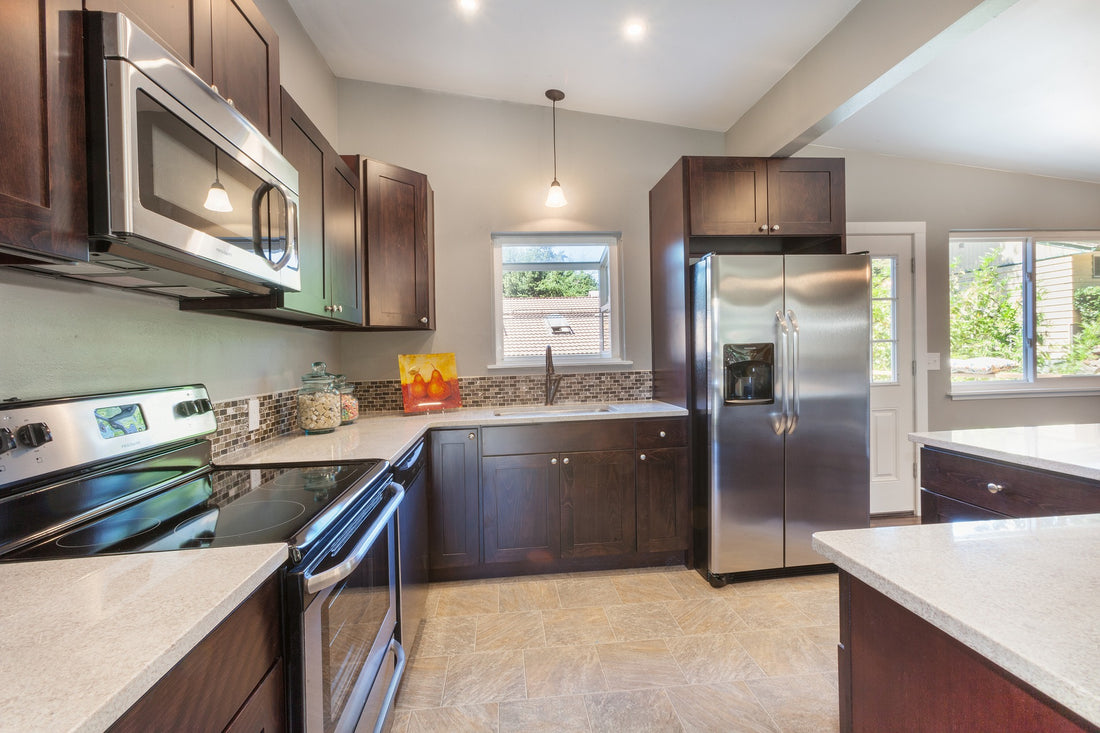From Fridges to Dishwashers to Stoves and Countertop Appliances
Kitchen appliances are large and heavy, and go through a lot of wear and tear. Because of their weight and rigidity, if the kitchen floor isn’t perfectly level (and let’s be honest most floors aren’t!), they will list or lean. This can cause doors to swing open, resulting in injury and annoyance. Luckily Wobble Wedge® plastic shims are perfect to shim and level your heavy kitchen appliances. Our sturdy appliance shims are ideal for stopping the annoying rocking and getting you back to cooking.
Shim Your Refrigerator
The refrigerator is definitely one of the largest appliances in the house, and if it rocks this can lead to doors swinging wildly, causing possible damage to cabinets or people. To level your fridge you will need a level, a friend, and some hard plastic Wobble Wedge® shims. Head over to our blog post “How to Level a Refrigerator” to get the details.
Level Your Stove
A wobbling stove is no fun to cook on. Instability plus hot food/surfaces do not make a good combination! Most stoves have adjustable feet, but if they don’t work or aren’t getting your stove to level, you need a solution. Hard plastic Wobble Wedge® shims can give you that needed stability. With the cook surface and oven completely cooled, place a level on the surface of the stove. Place the level both front-to-back and side-to-side to see where it’s out of level. On the level the side that the bubble moves to is the side that is higher. Meaning you need to shim the opposite side.
You likely won’t be able to shim the back side of the stove without moving it, so if it’s the back of the stove that’s the issue, you can try to lower the adjustable front feet to see if that solves the problem. Then place your hands on the cold stove and try to rock it. If it moves check the level and shim the side opposite from the bubble. You can safely stack multiple Wobble Wedge® plastic shims because of their patented interlocking ridges, so keep adding shims until the bubble is in the middle of the level.

Stop A Wobbly Dishwasher
If your dishwasher doesn’t fit snugly into place it can make a loud racket while it runs. Check to see if there are visible gaps around the sides, between the dishwasher and the cabinets. If there are, you can use soft/flexible Wobble Wedge® plastic shims to fill the gaps. Cut them to size with an exacto blade if needed. The soft plastic shims will stop the movement of the dishwasher, and also dampen the noise.
If the problem is from uneven flooring, remove the toe kick and be shocked at how much dust is under there 🙂 Then with the dishwasher completely empty and dry, place your hands on the front and gently rock the machine. Notice which feet lift up, place a hard plastic Wobble Wedge® shim under the foot that lifts off the floor. Try rocking it again, if it moves still, adjust the hard plastic shim, add another shim or try a larger shim (like our BigGap™ shims). Replace the toe kick and it should be good to go. Leveling with a level will be difficult in this situation since the top of the dishwasher is covered by your counter, so the best solution is to just shim it to stop the movement.
Shim your Microwave and other Small Appliances
Small countertop appliances can annoyingly rock or move out of place on slick surfaces. They also typically don’t have adjustable feet like larger appliances. So if they scoot around on your counter or wobble every time you open the door, you might want to shim them. Soft/flexible Wobble Wedges® plastic shims are ideal if the appliance is slipping around on your counter, because the patented interlocking ridges grip the slick surface. Place soft/flexible Mini Wobble Wedges® under the feet to stop sliding, or if you need a bigger shim use standard Wobble Wedges® to stop rocking and wobbling.
PLEASE NOTE: Wobble Wedges® should not come in contact with hot surfaces. DO NOT place Wobble Wedge® plastic shims against a surface that will become hot when the appliance is in use. Please always consult the appliance manufacturer’s instructions before attempting any adjustments to your appliances.


